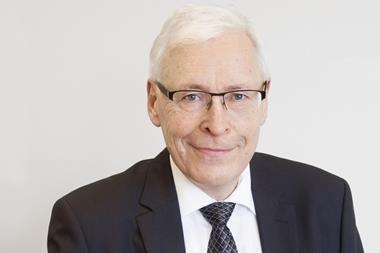The European directive on occupational pensions has resulted in the first of what are likely to be a large number of commentaries coming our way.
The most comprehensive comes from the European Federation for Retirement Provision (EFRP) which has published its legal commentary. The move comes amid what it terms “slow and piecemeal” implementation of the directive by EU member states.
The EFRP says the 69-page commentary, by Simon Arnot of law firm Steptoe & Johnson in Brussels, is “the first comprehensive, article-by-article legal analysis of the directive to be put in the public domain”.
EFRP chairman Alan Pickering says: “We hope that thorough discussion and analysis in advance of the implementation date will reduce the inevitable areas of misunderstanding and conflict to a minimum.”
The commentary follows on from the EFRP’s ‘EIORP 2005’ report but focuses on the directive as a legal framework for all IORPs, domestic and cross-border.
“The EFRP has long recognised the need to put forward an argued, comprehensive view of the directive in advance of the implementation date of 23 September 2005,” the body says.
“As yet, most member states have moved slowly and in a piecemeal manner in implementing the directive. However, the pace of national and cross-border activity is starting to quicken.”
Having a detailed commentary
such as that produced by Arnot will be helpful in the development of the discussion as the national discussions get underway. The Spanish may have moved on the directive as far back as February and the UK has included the cross-border elements in its new Pensions Bill, but apart from that there has been little progress towards implementation.
Arnot worked at the EC Internal Market Directorate during the crucial years of the inception of the directive. The EFRP says that this and his overall financial services expertise meant he was “admirably placed” to provide an independent review of its thinking on the pension funds directive.
His analysis confirms the EFRP’s approach on the main elements needed for the directive to realise the prudential preconditions for its European Institution for Retirement Provision, its model for pan-European cross-border pensions vehicles.
For the directive to make EIORPs a reality, the EFRP thinks that its cross-border provisions must be based on a single-supervisor approach. “The commentary argues that mutual recognition is matched by a single-supervisor approach.” This principle is firmly anchored in the directive as each IORP is in almost all situations only answerable to its own home state supervisory authority.
“If any host State prudential rules are imposed on non-domestic EIORPs, the primary enforcer is the EIORP’s own home State authority. The single EU licence also means that even where mutual recognition does not apply, such as any relevant national rules on social and labour law, these will be enforced in the first place by the home state supervisor.”
The commentary argues that “frontier formalities” faced by EIORPs may amount to no more than a check by the home state authority to see if it has any particular doubts. The burden of proof to show doubts lies with the home state authority and not with the EIORP. “Attempts to turn the cross-border check into a full positive vetting procedure will infringe the directive,” says the EFRP.
According to Arnot, as a rule, any authorised IORP can become an EIORP without any special home state regime applying. The principal difference between EIORPs and domestic IORPs is that the directive’s “full funding” standard, defined as possession of “sufficient and appropriate assets”, is applied to the cross-border operation without any opportunity for underfunding. This is the same standard – but applied more rigorously. Apart from this, all other standard home state rules apply.
“For any EIORP to realise its full potential, it must be able to put all assets for all its schemes, whether or not they relate to members in two or more member states, into one fund. Without this, economies of scale will be impossible to achieve,” says the EFRP. Arnot’s commentary identifies this as a key objective of the directive. The EFRP had argued in its report on EIORP that they should be able to achieve multi-jurisdictional compliance without sacrificing the single pool of assets and liabilities and economies of scale.
The commentary identifies one unclear aspect of the reporting rules, where Arnot argues that the directive is unclear as to whether it demands scheme-by-scheme annual accounts and reports as a general rule or just in certain circumstances. However, the EFRP believes that as obscure as the directive might be on this point, on balance it cannot be viewed as imposing scheme-by-scheme reporting as a general rule.
This matter is particularly important given that the information rules for members are the only general exception in the financial services area to the mutual recognition principle and will in any event require much cross-border coordination and goodwill between member states.
The ring-fencing issue is might be problematic, according to Arnot, especially if it were to break up funds. The EFRP’s analysis in its “earlier report on EIORPs is confirmed, it says: “a wide range of legal techniques could be regarded as ‘ring-fencing’. The challenge is to select the right method for the particular job without breaking up the fund. The various occurrences of the concept in the directive require a varied, context-sensitive approach. Once this has been achieved, compliance with any host state rules applicable on a cross-border basis will be relatively easy.”
It adds that the commentary confirms that appropriate varieties of ring-fencing should enable multi-jurisdictional compliance while achieving economies of scale.
The directive’s full funding standard is possession of “sufficient and appropriate assets”. How this is to be defined, though, remains an open question to be determined by each member state, mutual recognition means that whatever national standard is finally decided upon in each country, it must then be accepted by other member states without question. “However, where a home state allows temporary under-funding the full funding standard still applies to the cross-border operations. This means that the techniques for distinguishing domestic from cross-border operations will need approaching with particular care,” says the EFRP.
For any EIORP to realise its full potential, it must be able to put all assets for all its schemes, whether or not they relate to members in two or more member states, into one fund. Without this, economies of scale will be impossible to achieve, the EFRP argues. “The commentary identifies this as a key objective of the directive.” This backs up its earlier report
that EIORPs should be able to achieve multi-jurisdictional compliance without sacrificing the single pool of assets and liabilities and economies of scale.
It also points out that how financial services providers other than IORPs may use the directive is not as yet clear. The directive allows states to permit or require IORPs to “outsource” key management functions to other entities. “Since there is no restriction on what these may be, it may be possible for many more financial services providers to benefit from this possibility than hitherto believed.”
Overall the EFRP calls for sensitivity to be exercised when putting in place the general cooperative framework between states to ensure that conditions emerge for problem-free cross-border activity. The Committee of European Insurance and Occupational Pensions Supervisors. (CEIOPS) will be set to play a major role as regards the directive. But its mandate precludes it from “addressing” national social and labour law issues; it will have to confine itself to “communicating” national rules. This confirms EFRP concerns on possible issues in cross-border cooperation when it comes to compliance with relevant host state social and labour law.














No comments yet